| Pages:
1
..
41
42
43
44
45
..
77 |
gluon47
Hazard to Self
 
Posts: 81
Registered: 20-9-2015
Location: oceania
Member Is Offline
Mood: fluorinated and dying
|
|
Deflagration. Yeah that's what i meant. I can never remember that word
reality is an illusion 
|
|
|
crystal grower
Hazard to Others
  
Posts: 474
Registered: 3-1-2016
Location: Os Petrosum
Member Is Offline
Mood: Puzzled
|
|
Sodium bisulfate (original post in chemicals for crystal growing).
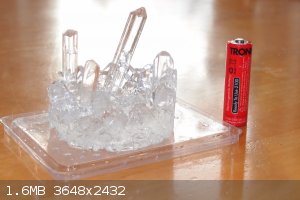
Btw. I have become "hazard to self "    . .
[Edited on 31-1-2016 by crystal grower]
|
|
|
Gooferking Science
Hazard to Self
 
Posts: 97
Registered: 17-7-2013
Location: Somewhere in Kansas, USA...
Member Is Offline
Mood: Halogenated
|
|
Some pictures of the inner grid of my fusor project. This is not at full vacuum or voltage. When the turbomolecular pump gets up to full speed, the
plasma extinguishes and it isn't near as pretty. So I took these pretty pictures at a slighly higher pressure.
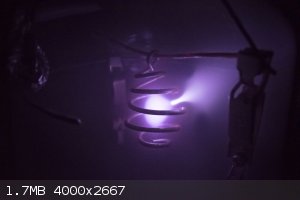 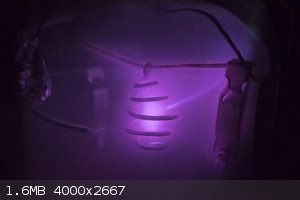
|
|
|
crystal grower
Hazard to Others
  
Posts: 474
Registered: 3-1-2016
Location: Os Petrosum
Member Is Offline
Mood: Puzzled
|
|
Quote: Originally posted by Gooferking Science  | | Some pictures of the inner grid of my fusor project. This is not at full vacuum or voltage. When the turbomolecular pump gets up to full speed, the
plasma extinguishes and it isn't near as pretty. So I took these pretty pictures at a slighly higher pressure. |
 WoW thats really impressive. WoW thats really impressive.
|
|
|
fluorescence
Hazard to Others
  
Posts: 285
Registered: 11-11-2013
Member Is Offline
Mood: So cold outside
|
|
Quite hard to see but I think the blueish stuff should actually be Manganate(V). As you may know it can be prepared by simply adding Sulfite to a very
alkaline solution of Permanganate at cold temperatures. Problem is it will appear green as is mixes with produced Mn(IV). And the Manganate(VI) is
green, too. So quite hard to distinguish them. That's why I thought of something else. To make the Manganate(VI) you heat NaOH and Permanganate dry
together. Now I added dry Sulfite to the mixture as well.
So in here is Sodium Sulfite, Potassium Permanganate and Potassium Hydroxide, all dry and then heated with a torch. Some yellow/brown Manganesedioxide
has formed but on one side you see an intense blue color which is probably the Manganate(V). I have to admit that I have never seen it before. Might
try different ratios till I get the mixture and temperature correctely.
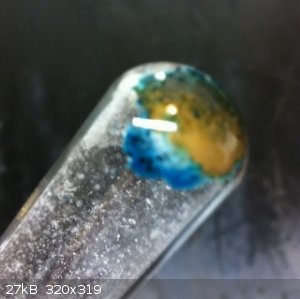
|
|
|
j_sum1
Administrator
       
Posts: 6320
Registered: 4-10-2014
Location: At home
Member Is Offline
Mood: Most of the ducks are in a row
|
|
@fluorescence
Nice work. Pretty colours. If you refine the procedure, please post. as it is, this is a nice little demo.
|
|
|
fluorescence
Hazard to Others
  
Posts: 285
Registered: 11-11-2013
Member Is Offline
Mood: So cold outside
|
|
Ground the components in a mortar, that is how it looked after some minutes. It started to turn dark green where the KOH powder took up water.
When I heated in it formed a liquid so I tried to cover the glass with it. It may look blue but its actually a mixture of blue-green. So might be
because its transparent or simply because it still has too much Mn(VI) in there but looks really nice.
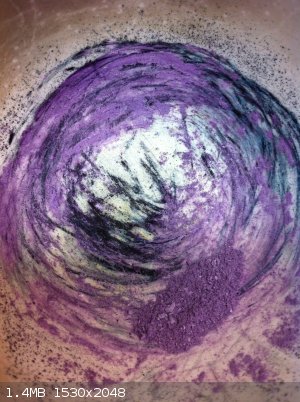 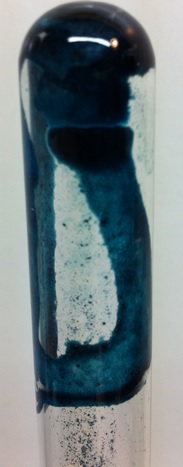
|
|
|
The Volatile Chemist
International Hazard
    
Posts: 1981
Registered: 22-3-2014
Location: 'Stil' in the lab...
Member Is Offline
Mood: Copious
|
|
Indeed, certainly pretty colors!
If I remember, I have some nice bacterial pictures I took at 1000x, using a Grahm stain. Lots of fun.
|
|
|
wg48
National Hazard
   
Posts: 821
Registered: 21-11-2015
Member Is Offline
Mood: No Mood
|
|
Pic of a glycerol complex of copper. Its more purple when viewed directly.
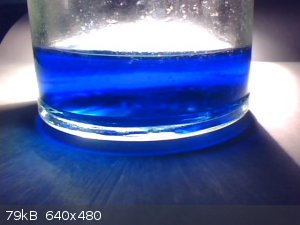
|
|
|
PHILOU Zrealone
International Hazard
    
Posts: 2893
Registered: 20-5-2002
Location: Brussel
Member Is Offline
Mood: Bis-diazo-dinitro-hydroquinonic
|
|
Could you be more specific? What complex and weight ratio?
PH Z (PHILOU Zrealone)
"Physic is all what never works; Chemistry is all what stinks and explodes!"-"Life that deadly disease, sexually transmitted."(W.Allen)
|
|
|
crystal grower
Hazard to Others
  
Posts: 474
Registered: 3-1-2016
Location: Os Petrosum
Member Is Offline
Mood: Puzzled
|
|
My little collection of minerals, synthetic minerals + some elements from my newly made collection.
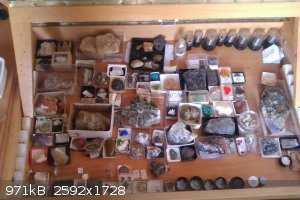 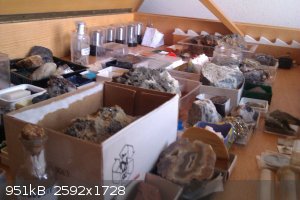
|
|
|
Velzee
Hazard to Others
  
Posts: 381
Registered: 19-8-2015
Location: New York
Member Is Offline
Mood: Taking it easy
|
|
Wow! I have to make me some K2Cr2O7 soon(when I get chromates). Do you have any radioactive minerals?
[Edited on 2/6/2016 by Velzee]
Check out the ScienceMadness Wiki: http://www.sciencemadness.org/smwiki/index.php/Main_Page
"All truth passes through three stages. First, it is ridiculed. Second, it is violently opposed. Third, it is accepted as being self-evident."
—Arthur Schopenhauer
"¡Vivá Cristo Rey!"
—Saint José Sánchez del Río |
|
|
crystal grower
Hazard to Others
  
Posts: 474
Registered: 3-1-2016
Location: Os Petrosum
Member Is Offline
Mood: Puzzled
|
|
Quote: Originally posted by Velzee  |
Wow! I have to make me some K2Cr2O7 soon(when I get chromates). Do you have any radioactive minerals?
[Edited on 2/6/2016 by Velzee] |
No, I haven't . But I want to obtain at least some uraninite or torbenite in the future.
In the photo you can see my recently made k2cr2o7 crystals.
They aren't very big becouse I haven't enough p.chromate . I must buy at least 300g  . .
(Sorry for the photo quality it was taken by my crappy mobile).
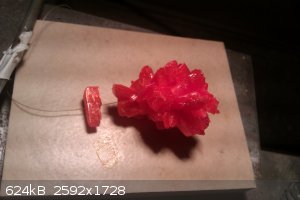
|
|
|
The Volatile Chemist
International Hazard
    
Posts: 1981
Registered: 22-3-2014
Location: 'Stil' in the lab...
Member Is Offline
Mood: Copious
|
|
Any modes of precipitation/crystallization/collection known?
|
|
|
wg48
National Hazard
   
Posts: 821
Registered: 21-11-2015
Member Is Offline
Mood: No Mood
|
|
I have found articles talking about powders but they only referenced the procedures for the production in an other article I did not have access too.
But I have not given hope of finding the procedure.
Trienthanolamine complexes of copper in water apparently can be precipitated with ethanol. That may be applicable to the glycerol complex. Perhaps by
adding more of the counter ion or lowering the ph would work.
I intend to try it with both complexes by adding the ethanol very slowly in an attempt to grow crystals. Very slow cooling from concentrated solutions
may also work. One problem is copper sulphate is not as soluble as nitrates and I only have the sulphate.
A macroscopic crystals of either complex will be interesting.
|
|
|
The Volatile Chemist
International Hazard
    
Posts: 1981
Registered: 22-3-2014
Location: 'Stil' in the lab...
Member Is Offline
Mood: Copious
|
|
Indeed. Perhaps acetone would work as a knock-out solvent for the complex?
It sounds like the complex has a similar color to the citrate-copper(2) complex I've made before.
|
|
|
wg48
National Hazard
   
Posts: 821
Registered: 21-11-2015
Member Is Offline
Mood: No Mood
|
|
Probably K2Cu(C3H6O3)2 ref: CHARACTERIZATION AND REACTIONS OF
COPPER (II)
|
|
|
wg48
National Hazard
   
Posts: 821
Registered: 21-11-2015
Member Is Offline
Mood: No Mood
|
|
Probably K2Cu(C3H6O3)2 ref: CHARACTERIZATION AND REACTIONS OF
COPPER (II)
|
|
|
wg48
National Hazard
   
Posts: 821
Registered: 21-11-2015
Member Is Offline
Mood: No Mood
|
|
last part of above post
COPPER (II) Probably K2Cu(C3H6O3)2 ref: CHARACTERIZATION AND REACTIONS OF
COPPER (II) GLYCEROL COMPLEX
by
HAZIMAH ABU HASSAN
July 1 998
for synthsis see ref: Preparation of Ultrafine Copper Powders with Controllable Size via Polyol Process with Sodium Hydroxide Addition
Pattanawong Chokratanasombat and Ekasit Nisaratanaporn
ENGINEERING JOURNAL Volume 16 Issue 4, ISSN 0125-8281 (http://www.engj.org/)
quote:In a typical synthesis, copper (II) nitrate trihydrate (Cu(NO3)2∙3H2O, Carlo Erba) was dissolved in the solution of sodium hydroxide (NaOH,
Mallinckrodt) and glycerol (C3H8O3, Carlo Erba) with varying the molar ratio of NaOH:Cu(NO3)2∙3H2O in the range of 0:1 to 5:1 and
Cu(NO3)2∙3H2O:glycerol at 0.02:1
I used 3:1 K not Na
[Edited on 9-2-2016 by wg48]
[Edited on 9-2-2016 by wg48]
|
|
|
wg48
National Hazard
   
Posts: 821
Registered: 21-11-2015
Member Is Offline
Mood: No Mood
|
|
Quote: Originally posted by The Volatile Chemist  | Indeed. Perhaps acetone would work as a knock-out solvent for the complex?
It sounds like the complex has a similar color to the citrate-copper(2) complex I've made before. |
I think acetone has a better chance of working. The Nickel complex is a green colour not very intense but Nickel chloride appears to be much more
soluble in glycerol (by volume) than copper sulphate so perhaps more chance of crystals. Perhaps copper chloride would be too.
|
|
|
The Volatile Chemist
International Hazard
    
Posts: 1981
Registered: 22-3-2014
Location: 'Stil' in the lab...
Member Is Offline
Mood: Copious
|
|
Quote: Originally posted by wg48  | Quote: Originally posted by The Volatile Chemist  | Indeed. Perhaps acetone would work as a knock-out solvent for the complex?
It sounds like the complex has a similar color to the citrate-copper(2) complex I've made before. |
I think acetone has a better chance of working. The Nickel complex is a green colour not very intense but Nickel chloride appears to be much more
soluble in glycerol (by volume) than copper sulphate so perhaps more chance of crystals. Perhaps copper chloride would be too.
|
Definitely try it! Looking forward to pictures.
|
|
|
fluorescence
Hazard to Others
  
Posts: 285
Registered: 11-11-2013
Member Is Offline
Mood: So cold outside
|
|
An old photo I found a bit off topic but still something quite unique. I think only Pok will be able to understand that but those two books are
"Chemische Experimente die Gelingen" from Roempp. A very important book for private chemistry which helped some generations with their experiments and
might be the origin of some experiments you see here on the forum.
The interesting fact about these two books is the date when they were published. The one on the left is my personal copy from 1941 printed during the
second world war.
The one on the right is quite hard to get. I think it was even Pok who told me about it's rarity but I might be mistaking here. I borrowed that from a
library, not sure from which since I gave this as an order for my local library to find it somewhere in Germany. Actually I wanted to find the very
first version but the sent the wrong book. To my great luck they sent me this one. It's from 1947 so shortly after the end of said world war and
printed in a completely different time. The first page says
That is was published under the supervision of the military government (US) and was limited to 5000 copies only.
So this book was censored by the military government after world war II and it was limited.
If you look at newer versions of that book in the 1960s for example there will be chapters about radiation and nuclear energy since this topic came
up. The last updated versions like 30 years ago were quite censored because of dangerous experiments. The one from 1947 was inbetween war and nuclear
energy so there is no additional chapter. It's just shorter than the other copies.
So mine, the one on the left is one of the last really uncensored versions. I'd like to have one from 1939, would be interested to know whether it
differs from the 1941 version. But mine has the additional war-chapters like
-"Charcoal as livesaver"
-"A model of a gas mask"
-"Why you can't fertilize with sodium chloride"
-"The secret of the knock-out-gun"
...
The picture shows both of them before I had to return the 1947 edition so close to each other like the have never been before and will probably never
ever be, telling two completely different stories it's just incredible to think about this.
[Edited on 11-2-2016 by fluorescence]
Attachment: phpqefW0n (45kB)
This file has been downloaded 848 times
[Edited on 11-2-2016 by fluorescence]
|
|
|
wg48
National Hazard
   
Posts: 821
Registered: 21-11-2015
Member Is Offline
Mood: No Mood
|
|
Follow up of the copper glycerol complex
Quote: Originally posted by The Volatile Chemist  | Quote: Originally posted by wg48  | Quote: Originally posted by The Volatile Chemist  | Indeed. Perhaps acetone would work as a knock-out solvent for the complex?
It sounds like the complex has a similar color to the citrate-copper(2) complex I've made before. |
I think acetone has a better chance of working. The Nickel complex is a green colour not very intense but Nickel chloride appears to be much more
soluble in glycerol (by volume) than copper sulphate so perhaps more chance of crystals. Perhaps copper chloride would be too.
|
Definitely try it! Looking forward to pictures. |
No acetone does not drop the complex but its only 5% miscible with glycerol. But I checked the mixture today and the acetone has gone blue and there
is a slight white precipitate in the glycerol layer.
So I put a drop of blue acetone solution on a slide in the hope it would evaporate and leave a blue compound.
The acetone evaporated leaving what I assume was mostly glycerol with a slight bluish colour. So I tried to evaporate the glycerol above a flame.
Before all the glycerol had evaporated what looked like a copper precipitate had formed. See the pic below. Sorry its not very good pic. The lighter
region of precipitate is still wet with glycerol.
So the complex can be extracted in to acetone. Perhaps vacuum distillation could remove the acetone and glycerol without decomposing the complex.
Incidentally the original purpose of the complex was to producer a nano copper powder for a glass artist.
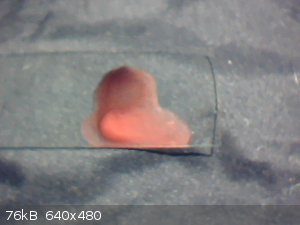
[Edited on 13-2-2016 by wg48]
|
|
|
3DTOPO
Hazard to Self
 
Posts: 64
Registered: 14-2-2016
Member Is Offline
Mood: No Mood
|
|
These crystals grew in front of my eyes the first time I applied power to a molybdenum disilicide (MoSi2) heating element. Some kind of oxide?
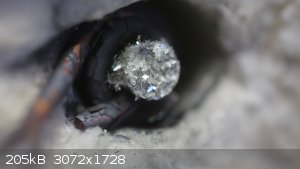 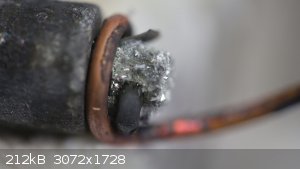
|
|
|
alexleyenda
Hazard to Others
  
Posts: 277
Registered: 17-12-2013
Location: Québec, Canada
Member Is Offline
Mood: Busy studying chemistry at the University
|
|
Results of 20 hours of inorg chemistry in my lab classes.
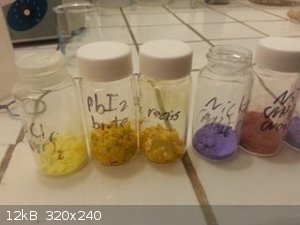 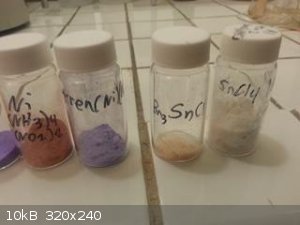
PbCl6(pyr)2, PbI2, recristalised PbI2, (Ni(NH3)6)Cl2, Ni(NH3)4(NO2)2, (tren)Ni(NO3)2, Bn3SnCl, SnCl4(DMSO)2
[Edited on 16-2-2016 by alexleyenda]
Help us build the Sciencemadness Wiki! Every question and tips about amateur chemistry two clicks away, wouldn't that be awesome?!
sciencemadness.org/smwiki
|
|
|
| Pages:
1
..
41
42
43
44
45
..
77 |